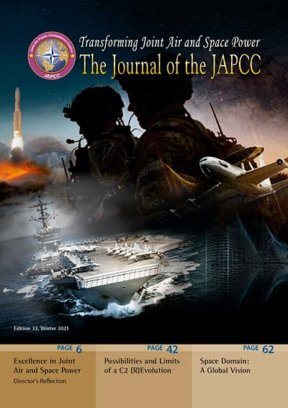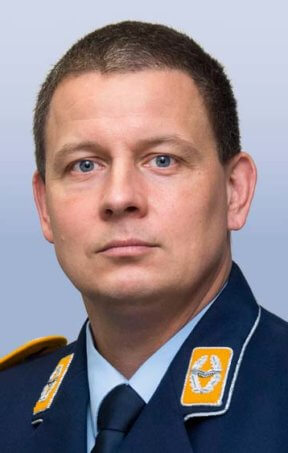Introduction
Space Support plays a significant role in modern warfare and is a key enabler for NATO’s technical advantage. Worldwide technological developments challenge this advantage while Space has become increasingly congested and contested.
This is the third article of a series focusing on the Responsive Space topic. The first article was released within JAPCC Journal 31 in February 2021 and focused on definitions and international doctrinal concepts. The second article, more technically focused, was released within the JAPCC Journal 32 in August 2021.
The previous two articles can be accessed here:
Responsive Space for NATO Operations – Part 1
Responsive Space for NATO Operations – Part 2
This final article will focus on potential examples of Responsive Space procedures and means for some of the Space functional areas and possible implementation options for NATO.
Responsive Space Options for the NATO Defined Space Functional Areas
Positioning, Navigation and Timing (PNT):
NATO has the chance to arrange a combination of the two Global Navigation Satellites Systems (GNSS): Global Positioning System (GPS) and Galileo.1 Galileo can be broadly considered as the responsive means to a degraded GPS support.
Notwithstanding the positioning and navigation service of PNT systems, the timing function is specifically crucial. Losing this support element causes degradations including, for example, encrypted communication links as the synchronization relies on the timing signal to be accurate. Responsive Space means are alternative synchronization processes and procedures that ensure persistent communication links. The process could also include a navigation feature using a reference system outside the degraded PNT environment.
Intelligence, Surveillance and Reconnaissance (ISR):
Responsive launches, in response to requests or degradation, do not directly support NATO operations as they are primarily national business. In turn, those nations further supporting NATO within the overall ISR process. If the launched payload is designated, even partly, to NATO as a tasking authority, this increases its added value. Small satellites with optical, radar, or even future quantum sensor capabilities would strengthen NATO’s ISR capabilities, if NATO nations were willing to share such information. Additionally, small satellites could be used for on-demand signal intelligence missions.
It should be standard practice for NATO to investigate the feasibility of utilizing more commercial support from western-based companies (NATO nations and partners) in order to increase its capacity, incorporate new capabilities, and to have a more resilient support base while relying on a wider number of legacy options.
Satellite Communications (SATCOM):
NATO should consider the integration of constellations or even mega-constellations, military or commercial, within its communication’s architecture. This will likely require hardware adjustments, but would increase communication resilience and ensure continuity of service. Outside of the Space-based communication services, there are a number of alternative solutions, such as airborne platforms, which should be explored to ensure better coverage in contested areas and to be able to close coverage gaps in case of degraded Space support services.
Space Situational Awareness and Space Weather:
It should be identified which products out of these functional areas are of the highest priority to NATO. Further exploration of which member nations can deliver these products and services allows for more resources and redundancy. This may be a chance for smaller NATO members to fill niches when they rely on additional sources for their products, such as those provided by commercial partners.
NATO Needs for Responsive Space Capabilities
As already analysed in the two previous articles, the military use of Space or the use of Space in general is vulnerable to intended counter-measures, referred to as counter-Space or Anti-Satellite Technology.2 The challenge is to ensure continuous Space support to NATO. In this context, Responsive Space capabilities and procedures can be seen as elements of deterrence.3 If a potential opponent is technically able to degrade Space services, to achieve a major effect, they will need a very complex set of procedures and technically advanced equipment. If this opponent knows, from official statements and publicly released doctrine, that processes are in place to buffer their counter-space activities and restore services, then they would normally be well advised to rethink their hostile intent.
Options to Integrate Responsive Space into NATO’s Operational Planning
It makes sense for NATO to know other member nations’ availability of Responsive Space procedures, and their sharing disposition. An initial step could be the voluntary establishment of a capability database detailing potential available Responsive Space means, spread over all domains. Secondly, it should be explored and agreed upon whether Responsive Space resources of a specific nation can be requested to ensure a continued support of a capability offered by the same nation. In a combined approach, it could also be possible to responsively close a capacity gap for another nation. If the combined support is then possible, a third step involving interoperability and compatibility for potential NATO use should be surveyed, as well as potential technical solutions. This approach allows bi- or multilateral solutions, strengthening the Alliance’s posture, with one nation offering Space support while another provides a potential interoperable Responsive Space solution. Technical challenges, bilateral requirements and solutions can be arranged and sorted in advance.
For every Space functional area, the responsible NATO entity to request Responsive Space support has to be identified. Establishing the communication community for SATCOM or the intelligence community for ISR are options. Further, the role of the new NATO Space Centre, a key element of NATO’s Space support, has also to be explored to coordinate Responsive Space actions. Establishing a network of points of contact, for the various capacities and capabilities, between the identified NATO entities and bodies to interact with the nations on the desired functional areas is of high value.
Specifically assigned or agreed policies therefore have to be included in operational planning and tested within exercises. This includes procedures on how to request Responsive Space means or actions to ensure the continued support. Deliberate exercising of corroborated responses will continuously increase knowledge and foster an environment in any headquarters for proper understanding of the related processes and procedures.
After summarizing the above Responsive Space opportunities, these should be analysed along the lines of the interdisciplinary approach, designed to be used in the Capability Development process, namely Doctrine, Organization, Training, Materiel, Leadership, Personnel, Facilities, and Interoperability (DOTMLPFI).
For NATO, in terms of Responsive Space, this could mean:
| Doctrine: NATO Space Defence Strategy addressing Responsive Space as a future capability. |
| Organization: Space Support coordination functionality; Space Centre as core element. |
| Training: Education and training through common exercises (Joint Warfare Wargames) or by means of a dedicated small satellite constellation. |
| Materiel: Specific equipment, systems, stores, and technologies (e.g. NATO owned and ground-operated segments). |
| Leadership: How to make proper use of Responsive Space capability within the alliance. |
| Personnel: Identifying specialists and/or specific skills (e.g. NATO Space Cadre). |
| Facilities: Infrastructures needed to accommodate, train, and prepare (e.g. Ground and Space segments). |
| Interoperability: Interfaces, requirements, and standards enabling Joint All Domain Operations. |
Further Research Options for NATO Bodies
NATO has the chance to integrate Responsive Space into NATO’s long-term focused NATO Defence Planning Process (NDPP).4 By virtue of this process, NATO identifies future requirements for technical or organizational capabilities. It is preferred within NATO that the required capabilities are developed or purchased within the Alliance. Inserting Responsive Space requirements into NDPP offers the option for combined approaches leading to interoperable standardized NATO processes.
Initial steps towards NDPP involvement has been done by the NATO Science and Technology Organization (STO) and can be been seen in the NATO Science and Technology Trends 2020–2040,5 released in 2020. Consequently, Space and Responsive Space will form the basis of a so-called ‘Technology Watch Card’, as well as a means to ‘explore a framework for standardization and interoperability for NATO multi-domain joint operations’. Both activities support the proposal to establish a database of available systems and products, and the ongoing standardization process towards interoperability. This finally leads into research activities on how to include NATO’s operational planning of the national Responsive Space means and procedures assigned to NATO.
Currently, NATO STO is investigating various aspects of Space and Responsive Space to benefit the future warfighter. The following is an excerpt of ongoing activities:6
- SCI-SAS-ET-058 on Alliance Space Deterrence Framework – Capabilities, Legal and Policy Analysis;
- SCI-346 on Space Risk Assessment Matrix;
- MSG-187 on Space Weather Environmental Modelling;
- SET-279 on Space-based SAR and Big Data Technologies to support NATO Operations;
- SET-274 on Cooperative Navigation in GNSS Degraded and Denied Environments;
- AVT-336 on Enabling Platform Technologies for Resilient Small Satellite Constellations for NATO Missions;
- SET-264 on Quantum Position Navigation and Timing for NATO platforms;
- IST-ET-115 on Free Space Optical Communication Networks.
As shown in the approaches before (DOTMLPFI, STO, NDPP), further research is needed by nations and NATO bodies, based on NATO requirements and across Space functional areas, to include future technologies such as Space robotics.
The increasing operational tempo requires global capabilities and near real-time availability of information across all domains. Even NATO member nations, without their own Space programmes, can contribute to resilience in Space by providing ground-based services. Both NATO and national Space security are collective activities.
Finally, the role of the Space Centre, which is defined as being ‘a focal point to support NATO missions with communications and satellite imagery, share information about potential threats to satellites and coordinate our activities in this crucial domain’7 has to be further developed. This is essential, especially for the claimed extended responsibilities for ISR and SATCOM, where overlapping responsibilities within the intelligence and communication communities have already been identified. Furthermore, the Space Centre’s role in the integration of Responsive Space means and procedures with national structures and procedures has to be explored and defined.
Overall Assessment and Conclusion
Technical developments, Space strategies and policies within the technically high-developed nations confirm the overall importance of Space and Responsive Space means within military operations. In the first two articles from this series, these topics were discussed and analysed for NATO nations and potential opponents. Based on this, NATO now has the chance, while further developing and implementing the Space domain into its processes and procedures, to embed the option to plan for Responsive Space means and procedures as a minimum. Based on the increased reliance of military units on the availability of Space services, validated by its extensive use during military operations, NATO should identify and further explore Responsive Space options as a priority.
These may include:
- Notwithstanding the recent declaration of Space as an operational domain, NATO should identify requirements that lead to definitions on how to potentially implement Responsive Space into operational planning.
- A continuous survey of available capabilities and capacities, as already proposed by STO in the Technological Watch Card.
- Initiate discussions with member nations to make Responsive Space means and procedures available to NATO.
- Include the Responsive Space topic in the NDPP, focusing on fostering combined interoperability and Alliance broad standards. This may include bi- or multilateral approaches where, for example, one nation is responsible for the Space capability and another for the specifically designed Responsive Space solution.
- Include the effects and the use of Responsive Space in NATO exercises and challenge the responsible entities.
- Deconflict potential responsibility overlaps between the intelligence and the communication communities and the Space Centre, to avoid duplications and misunderstandings.
- Analyse Responsive Space through the lens of capability development along the lines of the DOTMLPFI approach to exploit the maximum potential for NATO and its members.
- Implement Responsive Space operations into war games and identify the benefits to the warfighter.
- Support and conduct technology demonstrations for NATO and member nations to learn, adapt and act at the speed of relevance.














